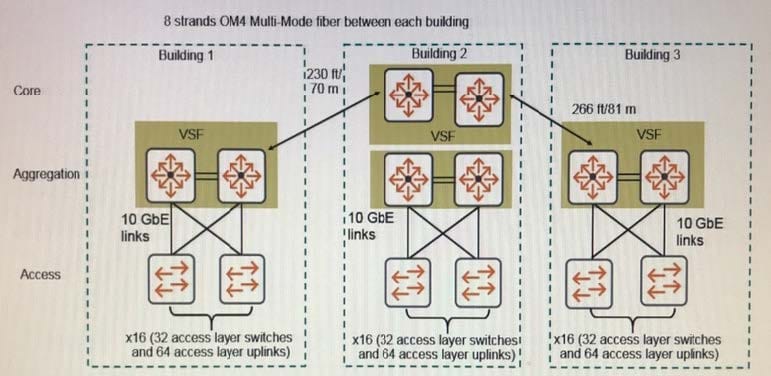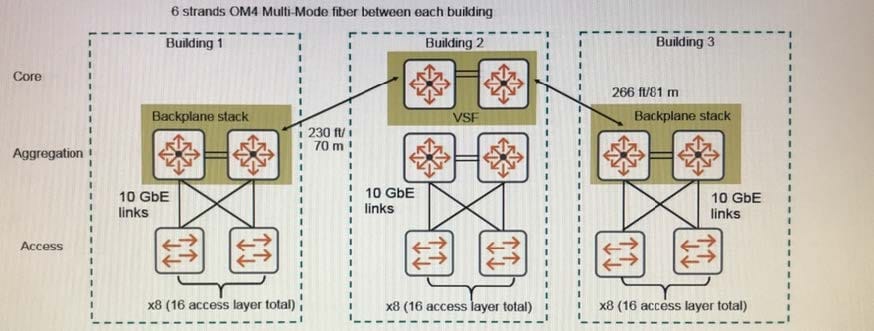Exam Details
Exam Code
:HPE6-A47Exam Name
:Designing Aruba SolutionsCertification
:HP CertificationsVendor
:HPTotal Questions
:68 Q&AsLast Updated
:Mar 23, 2025
HP HP Certifications HPE6-A47 Questions & Answers
-
Question 31:
An architect has an Instant AP (IAP) cluster at a mid-sized branch office. The IAP cluster now needs to tunnel corporate traffic to a Mobility Controller (MC) at the main office. However, the branch office should remain functional even if the link to the main office fails. Users at the branch office require access to main office resources, but do not require multicast services.
What is the recommended DHCP mode?
A. Local
B. Centralized L2
C. Distributed L2
D. Distributed L3
-
Question 32:
A customer needs an 802.11ac upgrade for an office with cubicles. The customer states that, because they planned locations for the existing 802.11n APs so that there are no coverage holes, they will simply deploy the new 802.11ac APs in the same location as the existing APs. The customer plans to support mobile devices in addition to laptops.
What should the architect explain about shy a site survey is desirable to determine the optimal locations for the new APs?
A. An 802.11ac deployment typically works better with side-mounted, rather than ceiling-mounted, APs, and a site survey will help determine the new mounting locations.
B. The new 802.11ac deployment should have a capacity-based design for the best performance, but the existing deployment sounds like a coverage-based design.
C. 802.11ac AP radios tend to be more sensitive to 2.4 GHz interference than 802.11n APs, so the architect needs to search for all potential sources of such interference.
D. 802.11ac APs can support a higher density of clients, so they can be deployed farther apart than the APs in most existing 802.11n deployments.
-
Question 33:
Refer to the exhibit.

An architect selects 5406R switches for the aggregation layer.
What is an appropriate amount of bandwidth for the link aggregation between each aggregation layer VSF fabric and the campus core?
A. 60 Gbps
B. 160 Gbps
C. 200 Gbps
D. 320 Gbps
-
Question 34:
A plan includes these security settings for the employee WLAN:
1.
WPA2-Enterprise with AES encryption
2.
802.1X with PEAP-MSCHAPv2
However, the customer wants to use certificates to authenticate user devices.
Which change brings the plan in alignment with the customer requirements?
A. Use EAP-TLS instead of PEAP-MSCHAPv2
B. The TKIP encryption instead of AES.
C. Add WPA2-PSK as an alternative to WPA2-Enterprise.
D. Add Tunneled TLS (TTLS) as an alternative to PEAP-MSCHAPv2.
-
Question 35:
An RF plan specifies wide sector directional antennas.
Refer to the antenna specifications.
H-plane refers to the Azimuth or Horizontal plane and E-plane refers to Elevation or Vertical plane.
Antenna 1: H-plane = 360; E-plane = 120
Antenna 2: H-plane = 360; E-plane = 60
Antenna 3: H-plane = 100; E-plane = 90
Antenna 4: H-plane = 60; E-plane = 60
Which antenna specifications indicate that the antenna is a good choice for the plan?
A. Antenna 1
B. Antenna 2
C. Antenna 3
D. Antenna 4
-
Question 36:
An architect needs to plan a very high density (VHD) wireless network at a large events venue, at which thousands of attendees are expected. The architect plans to deploy a cluster of Mobility Controllers (MCs) to control the APs. It is important to support seamless roaming for wireless devise across the venue.
What should the architect ensure for the network services?
A. DHCP servers can support a high number of scopes with a /24 size.
B. A third-party firewall integrates with ClearPass to filter the guest user traffic.
C. A domain CA is set up to deploy certificates to a high volume of guest devices.
D. DHCP and DNS servers are carrier-grade and support a low transaction time.
-
Question 37:
An enterprise needs an upgrade to 802.11ac. Users run applications such as Web, email, voice, and video. The architect needs to conduct an active site survey to plan 802.11ac AP locations. The noise floor is about -90 dBm across the site.
Based on Aruba best practices, what is the minimum acceptable signal that the architect should look for to determine the test AP range?
A. a signal of -65 dBm in the 2.4 GHz band
B. a signal of -75 dBm in the 5 GHz band
C. a signal of -65 dBm in the 5 GHz band
D. a signal of -75 dBm in the 2.4 GHz band
-
Question 38:
Refer to the exhibit.

An architect determines that 80 Gbps bandwidth is required for the link aggregation between the Building 1aggregation layer and Building 2.
Which transceivers should the architect recommend for each pair of switches?
A. two QSPF+ BiDi
B. two QSPF+ MPO
C. eight SPF+ LR
D. eight SFP+ SR
-
Question 39:
An architect needs to plan an 802.11ac wireless upgrade for a university building. What is one reason that it is important for the architect to identify auditoriums?
A. Auditoriums typically require a high-density AP design for RF coverage.
B. Users in Auditoriums often have Bluetooth devices, which can be a source of interface in the 5 GHz band.
C. Auditoriums typically require the use of 80 MHz channels to meet bandwidth requirements.
D. Auditoriums often require the use of DFS channels for sufficient 20 MHz channels.
-
Question 40:
An architect needs to deliver an upgrade to an 802.11ac-based solution for a customer. The customer requires an active site survey for the new deployment.
Which deliverable should the architect provide to the customer?
A. a heat map with proposed AP locations and actual tested coverage
B. a heat map with existing AP locations and actual tested coverage
C. a heat map with sources of RF interface, both 802.11 and non-802.11
D. the heat map with proposed AP locations and predictive coverage
Related Exams:
HP0-D15
Administering HP CloudSystem Matrix SolutionsHP0-D20
Architecting the HP Matrix Operating EnvironmentHP2-E56
Selling HP SMB SolutionsHP2-H88
Selling HP Business Personal Systems Hardware 2019HP2-I14
Selling HP Supplies 2020HP2-I15
Selling HP Business Personal Systems Hardware 2020HP2-I17
Selling HP Printing Hardware 2020HP2-I44
Selling HP Workstations 2022HP2-I73
Selling HP Retail and Hospitality Solutions 2024HP2-N51
HP Application Lifecycle Management 12.x Software
Tips on How to Prepare for the Exams
Nowadays, the certification exams become more and more important and required by more and more enterprises when applying for a job. But how to prepare for the exam effectively? How to prepare for the exam in a short time with less efforts? How to get a ideal result and how to find the most reliable resources? Here on Vcedump.com, you will find all the answers. Vcedump.com provide not only HP exam questions, answers and explanations but also complete assistance on your exam preparation and certification application. If you are confused on your HPE6-A47 exam preparations and HP certification application, do not hesitate to visit our Vcedump.com to find your solutions here.